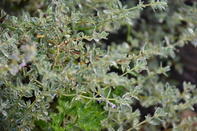
Scientific name: Thymus Vulgaris
Common Name: Thyme
Thyme is native to parts of Asia, Southern Europe and Mediterranean North Africa.
Plant Description
The Thyme plant is a hardy perennial and grows to about 350 mm in height. The plant produces numerous woody side branches to form a bush. The leaves are a dark green-grey, are a small oval shape and slightly furry. The flowers that form on the tips of the branches in a bunch are a lilac purple colour.Uses
Fresh and dried thyme is used as a culinary flavouring. It is also cultivated for the production of essential oils. For every kilogram of fresh thyme put through the distillation process, about 8 to 10 millilitres of essential oil is produced. The essential oil is used medicinally as a cure for sore throats and to control blood pressure and cholesterol.Soil Requirements and Preparation
Thyme grows best in a well-drained coarse, sandy soil with a pH of between 6.0 and 7.5. Before any soil preparation is done a representative soil sample should be taken and sent to a laboratory for analysis and nutrient recommendations. Thyme has a relatively shallow root system and its roots rarely develop deeper than 400 mm.
Soils should be ripped to loosen the soil profile to about 400 mm to ensure good drainage. Rectify pH levels by adding lime if soils are acidic and add manure or compost.
Plough into the top 300 mm of soil about four to five weeks before planting. In the final days before planting add trace elements and a balanced pre-plant fertilizer to the soil and disc harrow into the top 20 cm of soil. This will also clear any weeds that may have established. Install irrigation and plant the thyme seedlings.
Climate
Thyme is a hardy semi-evergreen plant that grows in warm dry Mediterranean climates and performs best in temperatures of between 20°C and 30°C. It is tolerant to frost once established. Soil temperatures should be above 16°C for good germination. Thyme can be cultivated in climates where there is at least 500 mm of rain spread over the year.Cultivars
There are three main types of thyme produced commercially: Citriodorus, Zygis and Varico. Common thyme is used mainly for culinary purposes. Citriodorus has a strong citrus scent and Zygis is used mostly for the production of essential oils.
Varico is also for oil, producing a very high quantity. There are over 200 varieties so when choosing what to plant it is best to get the advice of the local extension officer and seed specialists for the best variety for the production area and for your purpose and target market.
By Louise Brodie